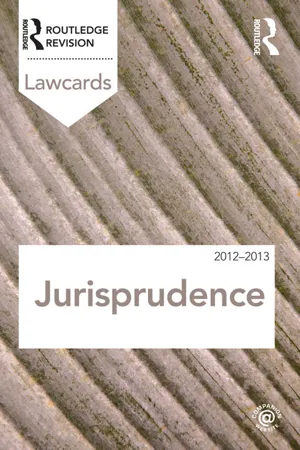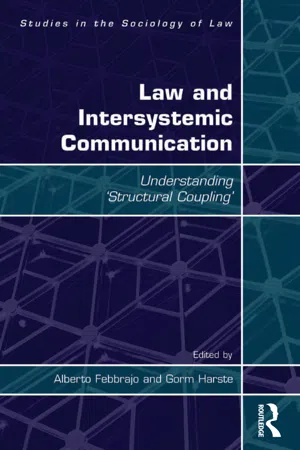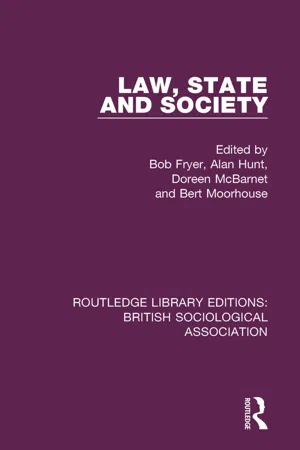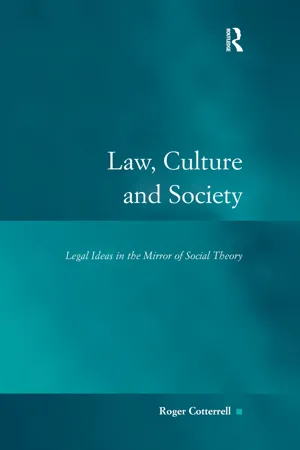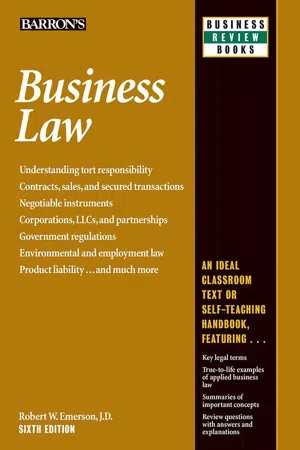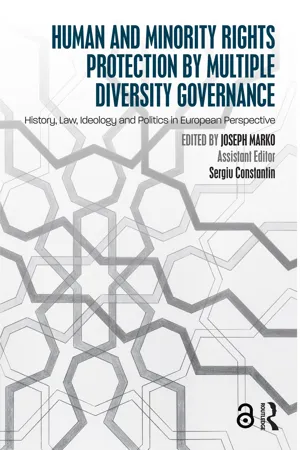Law
Law and Society
Law and Society examines the interaction between legal systems and social structures, exploring how laws are shaped by and in turn shape society. It encompasses the study of how legal rules and institutions influence behavior, as well as the impact of social norms and values on the development and application of laws. This interdisciplinary field considers the complex relationship between law and various aspects of human life.
Written by Perlego with AI-assistance
Related key terms
9 Key excerpts on "Law and Society"
- eBook - ePub
- Routledge(Author)
- 2013(Publication Date)
- Routledge(Publisher)
The various claims and interests can be discovered through an analysis of social data. Such claims and interests exist independently of the law and it is the function of the law to serve and reconcile them for the good of society as a whole. In this regard, Pound saw society as being static, cohesive and wholly homogeneous, with its members sharing traditions and values. In this case, the operation of law would be within an atmosphere of general consensus.SOCIO-LEGAL STUDIES
This is an approach to the question of Law and Society which has in recent years almost completely overwhelmed the field which has traditionally been occupied by sociological jurisprudence. Socio-legal studies, as a discipline, differs from sociological jurisprudence in that it does not have any specifically theoretical underpinning. Unlike the latter, which seeks to provide an analytical conception of the idea of law by looking at other social phenomena, the field of socio-legal studies is more concerned with pragmatic issues of how best to make the law, in its various aspects, work more effectively to achieve specific goals, usually identified with the idea of the rule of law or some notion of justice.Scholars in socio-legal studies are generally not concerned with explaining the nature of law or its place in society or in relation to the State. There is a general acceptance of the legal system in its essence as being a central element of social life whose position in regard to other social institutions and the State is essentially unproblematic. They instead advocate the recognition of law in its accepted social context, emphasising an empirical approach to the problems raised by the operation of the legal system and reform-orientated research which looks more to the ‘law in action’ than the ‘law in the books.THE SOCIOLOGY OF LAW
This field of legal study has gained precedence particularly in the last 35 years. It is different from sociological jurisprudence in its approach to the question of Law and Society, both in terms of its ideology and its methodology. Whereas sociological jurisprudence sought to provide an understanding of the nature of law through certain social phenomena, the sociology of law seeks to explain the nature of society - eBook - ePub
- Aharon Barak(Author)
- 2009(Publication Date)
- Princeton University Press(Publisher)
CHAPTER ONEBridging the Gap between Law and SocietyLaw and SocietyThe law regulates relationships between people. It reflects the values of society. The role of the judge is to understand the purpose of law in society and to help the law achieve its purpose. But the law of a society is a living organism.1 It is based on a factual and social reality that is constantly changing.2 Sometimes the change is drastic and easily identifiable. Sometimes the change is minor and gradual, and cannot be noticed without the proper distance and perspective. Law’s connection to this fluid reality implies that it too is always changing. Sometimes a change in the law precedes societal change and is even intended to stimulate it. In most cases, however, a change in the law is the result of a change in social reality. Indeed, when social reality changes, the law must change too. Just as change in social reality is the law of life,3 responsiveness to change in social reality is the life of the law.These changes in the law, caused by changes in society, are sometimes appropriate and sufficient. The legal norm is flexible enough to reflect the change in reality naturally, without the need to change the norm and without creating a rift between law and reality. For example, the legal prohibition against possessing weapons works well, without the need for change, whether the weapon is an antique pistol or a sophisticated missile. Often, however, the legal norm is not flexible enough, and it fails to adapt to the new reality. A gap has formed between Law and Society. We need a new norm. For example, the norm that the owner of a carriage owes a duty of care to a pedestrian may be flexible enough to solve the problem of the duty of care that an automobile owner owes to a pedestrian. However, it is not flexible enough to solve the problem of industrialization, urbanization, and thousands of cars traveling on the streets, a situation in which proving negligence becomes more and more difficult. We need a change in law to move from negligence-based liability to strict liability in the context of an insurance regime. When changes occur in social reality, many of the old legal norms fail to adapt. The tort of negligence, which can generally deal with various changes in conventional risks, will likely prove insufficient to address an atomic risk. We would need a formal change in the norm itself. - eBook - ePub
Law and Intersystemic Communication
Understanding 'Structural Coupling'
- Gorm Harste, Alberto Febbrajo(Authors)
- 2016(Publication Date)
- Routledge(Publisher)
How could law appear differently – not tied to the state? It would be much less definite than has often been assumed: a kind of regulatory spectrum, a normative network of ‘interlegality’ (Santos 2002: ch. 8), an inchoate ‘global legal pluralism’ in which state regulation plays a major part but in an overall pattern of regulatory relations that remains indeterminate. We need to make sense of this overall pattern in sociolegal theory – to map and conceptualise it to guide and integrate research – but without imagining that the pattern’s shifting shape can be captured in any definitive way. Useful practical criteria of the legal will not simply lead back to the state or any other single source of authority or coercive power, yet will recognise that the legacy of the Westphalian state system still powerfully colours most legal experience. The ‘law’ side of ‘Law and Society’ is in flux.Convergence Thinking and the Social
So too, however, is the ‘society’ side. The sense that sociolegal studies are somehow still trapped inside nation-state jurisdictions – separate political societies – has been addressed by scholars in various ways. Lynn Mather (2003) in a presidential address to the Law and Society Association in 2002 argued passionately that the LSA should adopt an increasingly international orientation. David Trubek, following her lead, advocated collaboration between organisations to build a ‘global sociolegal network’ (Trubek 2003: 302–3). As regards the research field itself, efforts have been made to lay foundations for a genuinely comparative sociology of law, deeply respectful of cultural differences but seeking to speak across them – breaking out of the research arena of distinct national societies.14Links of sociology of law with comparative legal studies have been strengthened: comparative lawyers increasingly recognise that they cannot assume (as dominant functional perspectives often do) that a social or economic problem addressed by law in one society is likely to be much the same problem in others (see, e.g., Örücü and Nelken eds 2007). Studies of transnational regulation inevitably presume diverse regulated populations, some being those of national political societies, others not. The nature of the social that this regulation addresses is an issue. For example, the European Union has provided a superb laboratory for exploring not only aspects of transnational regulation but the sociological character of the ‘Europe’ that constitutes their social setting (e.g. Delanty 2003; Delanty and Rumford 2005). The social indicated by legal transnationalism no longer equates with political societies of nation states. It is better seen as numerous, diverse networks of social relations of community, some coterminous with the boundaries of national political societies, others stretching across those boundaries; some embracing only certain aspects of the life of national political societies – affecting certain groups within these; others remaining indefinite or fluctuating in reach, as with certain extraterritorial applications of law or extradition practices, the incidence or effectiveness of which may be affected by power relations between states. So, in the perspective of legal transnationalism, the social – the ‘society’ to which law relates – varies in character and can be, in some ways, unstable and indefinite. - eBook - ePub
- Bob Fryer, Alan J. Hunt, Doreen McBarnet, Bert Moorhouse(Authors)
- 2018(Publication Date)
- Routledge(Publisher)
1LAW, STATE AND SOCIETY
Bob Fryer, Alan Hunt, Doreen Mcbarnet and Bert MoorhouseThe 1979 British Sociological Association Conference on Law and Society set out to achieve three aims, reflected in the choice of papers for this volume: first, to develop theoretical explorations in a field which had for so long been theoretically underdeveloped; second, and closely related, to encourage theoretically informed empirical investigation, as a conscious move away from what Campbell and Wiles have called the ‘socio-legal’ approach,1 focusing on pragmatically identified ‘problems’ and purporting to adopt a theoretically neutral empirical methodology; third, to redirect the focus of research from criminal law towards civil law and deeper underlying questions of the form of law. Criminal law may have been the logical focus for a sociology of law revived through radical criminology.2 But the roots of the sociology of law go back much further to the grand theorists, Marx, Weber, Durkheim, and to the core of sociological theory.Indeed the concerns of the sociology of law converge with the most important questions confronting contemporary sociology for reasons other than its historical roots. The sociology of law in Britain has barely reached the level of a recognised sub-discipline of sociology. It occupies a marginal place in the organisation of academic sociology and just as precarious position on the fringe of legal education. Yet the very fact of its late achievement of sub-disciplinary status has meant that it has not become entrapped in the self-protective specialisation which both protects and immunises many sociological sub-disciplines from the wider concerns of the social sciences as a whole. One major consequence of sub-disciplinary specialism manifests itself in the tendency for the sociology of law to become narrowly linked to the requirements of facilitating reforms in the administration of the legal process to such an extent that concern with the social and political context within which the legal system is located has received much less attention. It is thus significant that some of the work that has had the greatest impact on the field has come from people who are not ‘sociology of law’ specialists. Important examples of such interventions have been the very provocative discussion of ‘the rule of law’ by E.P. Thompson in the conclusion of Whigs and Hunters , in which he has insisted on ‘the unqualified human good’ embodied in the rule of law in opposition to the prevailing tenor of Marxist discussion which has relegated the rule of law as bourgeois ideology.3 Similarly the work of Stuart Hall and his colleagues in Policing the Crisis articulates an explicitly Gramscian perspective to the theorisation of law.4 - eBook - ePub
Law, Culture and Society
Legal Ideas in the Mirror of Social Theory
- Roger Cotterrell(Author)
- 2017(Publication Date)
- Routledge(Publisher)
Introduction Approaching LawPoints of Contact
This book argues that an adequate understanding of legal ideas – for lawyers, no less than for other citizens – is impossible without adopting a sociological perspective, a perspective informed by social theory. Social theory seeks to explain the nature of the social in general terms. It considers the general character of social relations, social institutions and social change. The book’s main aim is to show what such an approach to legal study entails and how it can illuminate basic problems, familiar to legal scholars, in interpreting and analysing contemporary law and studying its effects.The focus of the book is on legal doctrine – rules, procedures, principles, normative concepts and values in law and the specialized modes of reasoning applied to these. What makes doctrine ‘legal’ is its institutionalization: the fact that it is created, interpreted or enforced in certain socially established ways, through the use of recognized procedures and agencies. So, law is taken here to be institutionalized doctrine (see further Cotterrell 1995: Chapter 2 ). My concern is with the sociology of legal ideas, but not only with legal ideas that are familiar to lawyers. From a sociological viewpoint, there may be more to law than the legal doctrine that lawyers recognize and work with. Law as institutionalized doctrine can be found outside the ‘official’ legal system of the state. Law, in some sense, may flourish in social sites and settings where lawyers or police never venture. Equally, it could be a mistake – looking at matters sociologically – to think that the state legal system is necessarily a unified entity. The law created, interpreted and enforced by the state is itself sometimes subject to fierce internal conflict or competition, with different agencies of the state adopting different legal positions, or with potential contradictions unrecognized or unresolved. The coexistence, and sometimes conflict, of legal regimes and sources of legal authority in the same society is a central idea of ‘pluralist’ views of law, and a legal pluralist view – explained and defended in Chapter 2 - eBook - ePub
- Robert W. Emerson(Author)
- 2016(Publication Date)
- Barrons Educational Series(Publisher)
THE Law and Society1ORIGIN AND NATURE OF LAWKEY TERMSTHE ORIGIN OF LAWlaw that which a judge will decide concerning matters properly brought before him/her; in a broader sense, any rule that society will enforcecode in the common law, a collection of statutes enacted by legislative bodies, including Congress and state legislaturesCivil Law codified law based on the Roman code of Justinian; the basis of the legal system of almost all European and Latin American countries as well as many African and Asian nationscommon law law as developed and pronounced by the courts in deciding cases (“case law”), based on the common law of England and judicial precedentThe origin of law is as obscure as the origin of society, since the existence of law is a precondition of society. In its most primitive, unreasoned form, law rests on brute power—the ability of one individual to control other individuals through strength. The lex talionis , the law of retaliation (an eye for an eye, a tooth for a tooth), arose from the natural impulse of individuals. As societies formed, this impulse was sanctioned by government as law. The law of damages is the substitution of monetary compensation for blood or retribution in kind.As time passed, however, it became necessary to adopt rules governing the conduct of individuals toward one another and the conduct of a single individual toward the body of individuals as a whole (society). Certain laws were enacted, or evolved and developed, for different purposes:1. To proscribe certain kinds of behavior that society finds objectionable. This is public law and concerns a citizen’s relationship with society constituted as government. Public law includes constitutional, administrative, and criminal law and many forms of antitrust law, environmental law, labor law, and securities regulation.2. To make an injured party (citizen, corporation, or other entity) whole. This is private law - eBook - ePub
Just Silences
The Limits and Possibilities of Modern Law
- Marianne Constable(Author)
- 2009(Publication Date)
- Princeton University Press(Publisher)
Taking their cues from legal realism, sociolegal studies of law criticized what they perceived as narrow approaches to law that restricted it to doctrine or to ostensibly problem-solving rules. Lawrence Friedman, for instance, contrasts law-and-society scholarship to an understanding of law as “norms, or language or ideology, or rhetoric or ‘consciousness,’ or discourse—anything but behavior.” He argues for values of “clarity, honesty and rigor,” which he claims the social scientific study of institutions and behavior offers to both speculative law school law and lawyers’ instrumentally rational policymaking. 1 During the past two or three decades, however, sociolegal scholars, like scholars in other fields, have come to recognize that the uniqueness of law as phenomenon cannot be captured without some acknowledgment of law’s discursive character. They have approached law accordingly, seeking to incorporate, as subject matter in their largely empirical analyses of society and power, the language of law. Thus there have emerged various approaches to legal language, both the language of official law and the nonofficial language of law. On the whole these studies treat language in one way or another as social power. Some view language as more-or-less in the control of a speaker; others view language as itself a cause of effects; still others combine the two approaches in understanding language as an instrument or tool. Many identify language with domination - Kirk Junker(Author)
- 2016(Publication Date)
- Routledge(Publisher)
15 we can see the strong role of social participation in conflict resolution. To prophesize a court’s resolution is to anticipate more than the one right meaning of a text. The education, training and practice of U.S. lawyers reflect the thinking, skills and approaches to law from U.S. culture. And by doing so they shape the society in which they teach, publish or practice law. Therefore, a study of those influences in both directions goes far to aid understanding of U.S. legal culture when seen through the social reference frame by lawyers.5.1.1 The Social Approach to the Legal ActorsWhile the United States did not copy English legal education, training and the organization of legal practice, those elements did influence U.S. legal culture. The types of lawyer who have studied and practiced law throughout history in England were far more numerous than today. At one time in the late Middle Ages, at least six different designations existed: the sergeant-at-law, the clerk, the attorney-at-law, the apprentice-at-law, the utter-barrister and the solicitor.By the middle of the sixteenth century only two distinct types of lawyer remained in England, resulting in two branches of the profession, both of which are still fully in operation in England today: barristers and solicitors. A solicitor meets clients, drafts all manner of legal documents and advises whether a dispute should go before the court to be adjudicated. If the solicitor believes that a dispute will need to go before the court, then it is the job of the solicitor, not the party, to obtain the services of a barrister. It is the barrister who presents the dispute to the court using the advocate’s skills of questioning witnesses and using their testimony to make other evidence admissible to the court. Although solicitors do today have some right of audience before the courts themselves, socially they have not yet begun to exercise the right to any great extent and still largely call upon the services of a barrister for oral advocacy in the courtroom. The client pays the solicitor for all legal services, and it is the solicitor who then pays the barrister when a barrister is needed. Barristers and solicitors are still educated and trained separately. Barristers may not work together in law firms and instead are tenants in chambers. The chambers may share secretarial services but not cases. By contrast solicitors usually work together in solicitors chambers. This requirement for barrister independence predictably results in a high failure rate among new barristers.16- eBook - ePub
Human and Minority Rights Protection by Multiple Diversity Governance
History, Law, Ideology and Politics in European Perspective
- Joseph Marko, Sergiu Constantin(Authors)
- 2019(Publication Date)
- Routledge(Publisher)
for all possible future parties of judicial disputes). 2.2 Theoretical approaches and methods in sociology and political sciences After this overview on how lawyers think and work in practice, in particular from a legal-dogmatic perspective, we now turn to the two other fields we mentioned in the introductory chapter. The first is the analysis of fundamental values and normative principles as functional reference for political decision making, which is covered by the academic disciplines of political philosophy, legal philosophy, political theory and the history of ideas. The second is the field of empirical analysis of the effects of law (i.e. rule-making, rule-application and rule-adjudication), in particular covered by the academic discipline of sociology of law. Most confusions and intercultural misunderstandings between scholars in different academic disciplines of the social sciences, humanities and law result from the fact that they very often use the same terms such as state or institution to mean different specific things. Thus, when sociologists, political scientists or lawyers use the term ethnic group, this can be seen – throughout this book – as a linguistic abbreviation or shorthand term for the complicated cognitive and emotional assumptions and empirically observable processes underlying the verb to act and its implicit conceptualisations of human behaviour as communication or (inter-)action
Learn about this page
Index pages curate the most relevant extracts from our library of academic textbooks. They’ve been created using an in-house natural language model (NLM), each adding context and meaning to key research topics.
